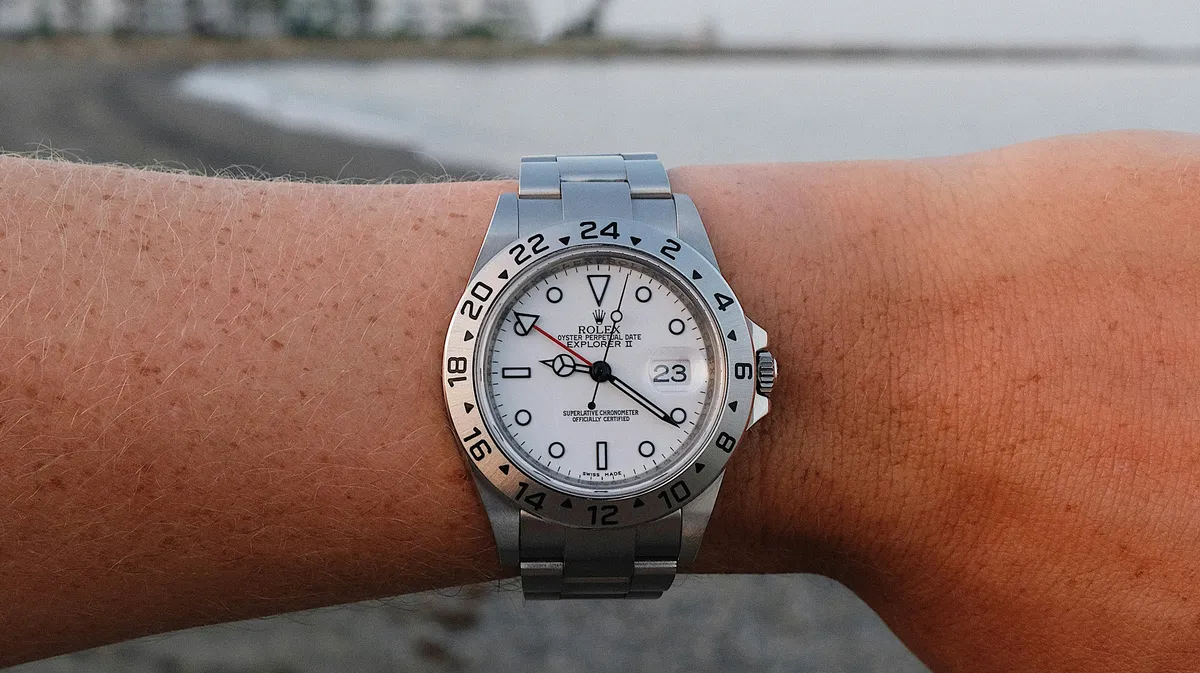Key Takeaways
- Cyclops magnification: Genuine Rolex features 2.5x magnification on the date window. Misalignment or poor magnification? Likely fake.
- Weight and materials: Authentic Rolexes use high-quality metals, resulting in substantial weight. Lightweight or cheap-feeling? Red flag.
- Serial and model numbers: Real Rolexes have crisp, deep engravings. Faint or dotted numbers? Probably counterfeit.
- Movement and sound: Genuine Rolexes have a smooth second-hand sweep (8 ticks/second). One-tick-per-second? It’s fake (unless it’s the rare Oysterquartz).
- Price and source: Significantly discounted Rolexes from unofficial channels are likely fake. Stick to authorized dealers for guaranteed authenticity.
1. The Cyclops Magnifier Reveals the Truth About Your Rolex
The Cyclops magnifier is a dead giveaway when spotting a fake Rolex. On genuine Rolexes, it’s not just there for show – it magnifies the date by 2.5 times. Counterfeiters often mess this up.
Look closely at the magnification. If it’s weak or distorted, you’re probably dealing with a fake. But don’t stop there. Check the alignment too. A real Cyclops sits perfectly centered over the date window. Any misalignment? Red flag.
Some high-end replicas have gotten the magnification right, but they often slip up on the details. Look for signs of glue around the edges or bubbles in the magnification. Real Rolexes don’t have these imperfections.
Remember, not all Rolex models have a Cyclops. But for those that do, it’s a critical authenticity check. Master this, and you’re one step closer to spotting fakes like a pro.
2. Examine the Weight and Materials for Authentic Luxury
When you hold a genuine Rolex, it feels substantial. These watches are crafted from premium materials like 904L stainless steel or precious metals. The weight difference between authentic and fake Rolexes is often noticeable.
Counterfeiters can’t afford to use the same high-grade materials. They opt for cheaper alternatives that don’t match up in weight or quality. An authentic Rolex Daytona, for instance, weighs around 140 grams with the bracelet. A replica might barely hit 115 grams.
The texture and finish of genuine Rolex materials are impeccable. Run your fingers over the surface – you’ll feel the precision engineering. Fakes often have a rougher feel or inconsistent finish. Look closely at the joins between links in the bracelet. On a real Rolex, these are seamless and tight.
Remember, Rolex doesn’t cut corners on materials. They use their own foundry to create proprietary alloys like Rolesor and Everose gold. These unique compositions contribute to the watch’s durability, luster, and yes – its weight.
Don’t be fooled by a light watch or one that feels “off” in your hand. Trust your senses. If it doesn’t feel like the luxury piece it claims to be, it probably isn’t.
3. Decipher the Secret Code of Rolex Serial and Model Numbers
Serial and model numbers are the DNA of a Rolex watch. They’re not just random digits; they’re a fingerprint of authenticity.
On a genuine Rolex, these numbers are deeply etched with precision. They’re crisp, clean, and catch the light like a diamond-cut edge. It’s craftsmanship you can see and feel.
Fakes? They drop the ball here. Their numbers often look like they were drawn with a shaky hand or etched by a drunk ant. You’ll see faint dots or a sandy texture instead of sharp lines. It’s the difference between a surgeon’s scalpel and a kid’s crayon.
Here’s the kicker: counterfeiters love to recycle. They’ll slap the same serial and model numbers on different watches. Real Rolexes? Each one’s unique. Like a snowflake, but worth a lot more.
Don’t just look at the numbers; verify them. Rolex has a system. Each number corresponds to a specific model and configuration. If the numbers don’t match the watch you’re holding, you’re looking at a fake. Simple as that.
Remember, these engravings aren’t just decoration. They’re Rolex’s way of saying, “This is the real deal.” Learn to read them, and you’re one step closer to spotting the genuine article in a sea of knock-offs.
4. Listen Closely to the Ticking Sound of Genuine Rolexes
The ticking sound of a Rolex isn’t just noise—it’s a signature. Most Rolexes don’t tick once per second like quartz watches. Instead, they have a smooth sweep with eight ticks per second. This comes from their automatic “Perpetual” movements.
Here’s the deal: Put a genuine Rolex to your ear. You should hear a rapid, precise tick—not the one-per-second rhythm of cheap watches. It’s like the difference between a purring engine and a sputtering one.
But don’t get cocky. Some high-end fakes now mimic this smooth sweep. So while the ticking sound is a good indicator, it’s not foolproof. Use it as one piece of the puzzle, not the whole picture.
Remember the Oysterquartz? It’s the exception. This rare Rolex model does tick once per second because it uses a quartz movement. But unless you’re dealing with this specific model, a one-tick-per-second Rolex is likely fake.
Bottom line: Listen closely, but don’t rely solely on your ears. Combine this with other authentication methods to spot a fake Rolex like a pro.
5. Unveil the Mystery of Rolex Movement Direction
Gently pull out the crown and rotate it upwards. In a genuine Rolex, the hands move clockwise. Always. Regardless of model number.
Here’s where it gets interesting: Chinese movements and clones often move anti-clockwise. It’s a dead giveaway you’re dealing with a fake.
But don’t get complacent. Some high-end replicas have nailed the clockwise movement. They’re using clone Rolex movements that mimic the real deal with scary accuracy.
The direction of movement isn’t foolproof, but it’s a quick and easy check. If those hands are going the wrong way, you’ve definitely got a counterfeit on your hands.
Remember, this is just one piece of the puzzle. Combine it with other authentication methods for a more comprehensive assessment. And if you’re still not sure, get it checked by a pro. Better safe than sorry when you’re dealing with a luxury timepiece.
6. Scrutinize the Clasp for Telltale Signs of Authenticity
The clasp of a Rolex isn’t just about keeping the watch on your wrist. It’s a testament to the brand’s obsession with detail and quality.
Genuine Rolex clasps are engineering marvels. The crown on the clasp? It’s not just slapped on there. It’s seamlessly embedded into the metal, like it grew there naturally. This level of precision is hard to fake.
But counterfeiters try. And they often fail spectacularly. Look for these red flags:
- Crooked crown: If it’s not perfectly aligned, it’s not Rolex.
- Raised crown: Should be flush with the metal, not sticking out.
- Poor quality feel: Authentic clasps have a solid, premium feel. Fakes often feel flimsy.
Remember, Rolex doesn’t cut corners. Every part of the watch, down to the tiniest detail on the clasp, is crafted with extreme care. If something feels off, it probably is.
Don’t be fooled by good-looking fakes. Some replicas have gotten scarily good at mimicking the clasp. But they still can’t match the overall quality and attention to detail of a real Rolex. When in doubt, compare it side-by-side with a known authentic piece. The differences will be clear.
7. Spot the Micro H Crown That Defines Real Rolex Craftsmanship
The micro H crown is a tiny, laser-etched crown on the crystal at the 6 o’clock position. It’s a subtle yet significant detail that separates authentic Rolexes from most counterfeits.
Spotting this miniature marvel isn’t easy. You’ll need a keen eye, good lighting, and possibly a magnifying glass. Tilt the watch at different angles until you catch a glimpse of that tiny crown shimmering on the crystal.
Here’s the kicker: not all genuine Rolexes have this feature. It’s primarily found on models produced after 2002. Vintage pieces and some older models won’t sport this microscopic mark. So while its presence can confirm authenticity, its absence doesn’t automatically scream “fake.”
Counterfeiters are getting smarter, though. Some high-end replicas now include this detail, making it just one piece of the authentication puzzle. Don’t rely solely on the micro H crown to determine if your Rolex is real. Use it in conjunction with other telltale signs we’ve discussed.
Remember, if you’re still unsure, consult an authorized Rolex dealer. They have the expertise to spot even the most sophisticated fakes. When it comes to investing in luxury timepieces, it’s better to be safe than sorry.

